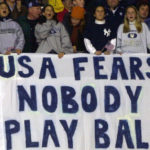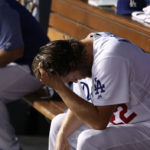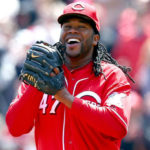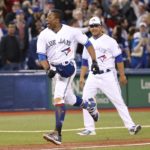YouTube Video Uploaded by the Baseball Gods
by J.W. Steinberg | May 30, 2019
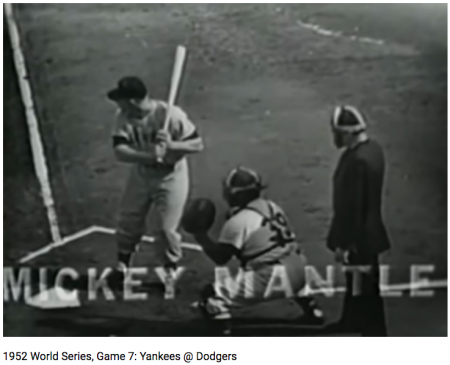 A gift-wrapped present from the baseball gods. The chance to see eight future Hall of Famers in one baseball game, plus a few others who came close to being Hall of Famers. All in an action-packed game seven of the 1952 World Series between the New York Yankees and the Brooklyn Dodgers.
A gift-wrapped present from the baseball gods. The chance to see eight future Hall of Famers in one baseball game, plus a few others who came close to being Hall of Famers. All in an action-packed game seven of the 1952 World Series between the New York Yankees and the Brooklyn Dodgers.
Somehow I found my way over to YouTube and there it was: a nugget from the baseball gods. An orphan. Alone, in a column of entertainment selections.
Comedies. Current video shorts. Reality TV snippets. Old black and white game shows. Documentaries, and so forth.
Oh You Beautiful Nugget
Game seven of the 1952 World Series between the New York Yankees and the Brooklyn Dodgers.
I clicked on the YouTube link to the black and white broadcast. Little did I know that, as noted by Wikipedia, the NBC telecast I clicked on was preserved via kinescope by the game sponsor, Gillette. So, what popped on was believed to be the oldest surviving telecast of a World Series game.
And even as primitive as the broadcast angles and camera work was, the telecast was still a fascinating historical record of an epic competition, 67 years old.
The telecast began and immediately Mel Allen chimed in with his sonorous Alabama timber about the riveting series that had unfolded so far. Six momentous performances. Endless lead changes. Pitching moves galore. (Casey Stengel was known to have little patience with pitchers, yanking them out of games at the first sign of trouble. A tactic Sparky Anderson would mimic effectively a quarter century later.) Add in heartbreak and the thrill of victory, three times for each team, and this recipe for scintillating competition baked quite a panoply.
It was made even more special by the mere 12 or so miles that separated Yankee Stadium from Ebbets Field. Fierce partisanship characterized the fans who attended the games, even the many fans dressed in suits, ties, and hats who hooted and hollered, layering an additional passion over the grainy charcoaled action.
Play Ball!
The telecast began with the starting pitchers warming up on flat mounds just to the side of home plate. Eddie Lopat of the Yankees threw on the left side of the screen wearing his gray road uniform. While Joe Black wore his baggy Dodger blue on the right side of home plate.
While the telecast was primitive compared to today’s broadcast standards, the initial picture, shot from a camera in the stands behind home plate, painted a dramatic snapshot of what was ahead. Both starters mechanically went through their routine as the camera studied their movements before panning Ebbets Field to show anxious fans awaiting the first pitch from the baseball gods.
The camera showed why Ebbets Field was known as a bandbox. It was packed action and eager fans into a tight container. Even the bullpens were located on the field, inside the foul lines deep in the outfield corners. Nothing was hidden, as is the case in today’s game where fans need binoculars to see who’s warming up in the bullpen.
This everythingness about the baseball experience brought me back many years when stadiums were quirkier with non-symmetrical dimensions (like the old Polo Grounds and Fenway Park today) and irregular shapes. When home-field offered an advantage and fans sat closer to the action. When baseball was less technology and more personal touches straight from the baseball gods.
Even the six umpires on the field were attired differently. The umpire behind home plate, Larry Goetz, a National League umpire, wore his chest protector inside his dark coat. American League umpires who called balls and strikes wore balloon chest protectors outside their coats. Which translated into high strikes in the American League, and a low strike zone in the National League, due to the way umpires setup behind the catcher.
As the game inched along from inning to inning, tensions rose. The Yankees scored first in the top of the fourth. Brooklyn followed with a run in the bottom of the inning. And with the score tied at two next inning, Mickey Mantle homered over the right-field fence in the sixth and then singled in the fourth and winning run in the seventh inning.
Casey Stengel brought in left-handed pitcher Bob Kuzava (the pitching star of the game, throwing 2.2 scoreless innings and earning a save) with the bases loaded in the bottom of the seventh. Kuzava induced popups from Duke Snider and then Jackie Robinson to end the inning.
On Robinson’s popup, Billy Martin, the Yankee second baseman, sprinted in on the dead run, extended his glove as he reached the pitching mound and willed the ball into his mitt. This catch not only became part of the Billy Martin myth but preserved the Yankees 4-2 lead.
Ralph Branca was thrown out of the game in the Brooklyn half of the eighth inning for tirelessly heckling home plate umpire, Larry Goetz. Allen commented that Branca was only the second player in World Series history to be thrown out of a game.
In the bottom of the ninth Brooklyn recorded three quick outs and the inning ended in a whimper. After the last fly ball was corralled, the Yankees exploded in jubilation and raucously celebrated another World Series victory to the dismay of the Brooklyn faithful.
The Yankees Jumped for Joy
The game over, there was a clear difference between the way the managers approached the game. Casey Stengel was visible throughout in the dugout and on the mound seemingly every inning. He was not afraid of changing pitchers, or using platoon advantages.
Charlie Dressen, the Brooklyn manager, on the other hand was almost invisible. It seemed that every move Stengel made seemed to work, while Dressen’s tactics barely affected the game.
Mel Allen and Red Barber recapped the Series, but did not comment on the managerial differences. Nor did they highlight Mickey Mantle’s stellar performance in this pivotal game seven. Mantle and Bob Kuzava made the difference for the Yankees.
Mel Allen removed his hat and scratched his head several times, on camera, looking slightly off-camera. As Allen scratched, it struck me how different this era of baseball television was from today’s telecasts. Less scripted, more spontaneous – and more honest.
An on-camera personality would never be allowed to scratch his person on camera today. And even though the banter between Allen and Barber at the end of the game was pithy and informative, only one man did the play-by-play at a time during the game. No color commentary. So either Allen spoke or Barber, never the two in one sequence.
It was Red Barber who referred to Ebbets Field as located close to the banks of the Gowanus Canal. Given the filthy, putrid, polluted squalor of the canal today, Barber’s comment was as fresh as tall cotton.
Barber ended the telecast with an ode to the fans, Happy Sailing, and Happy Shaving – a reference to the sponsor, Gillette. The banality of the words was so 1950s.
The Eight Hall of Famers
On the Yankees side of the field the Hall of Famers were, Yogi Berra, Mickey Mantle, Johnny Mize, and Phil Rizzuto.
While Brooklyn’s Hall of Famers were, Roy Campanella, Pee Wee Reese, Jackie Robinson, and Duke Snider.
The best Hall of Famer on the field that day was Mickey Mantle, hands down.
